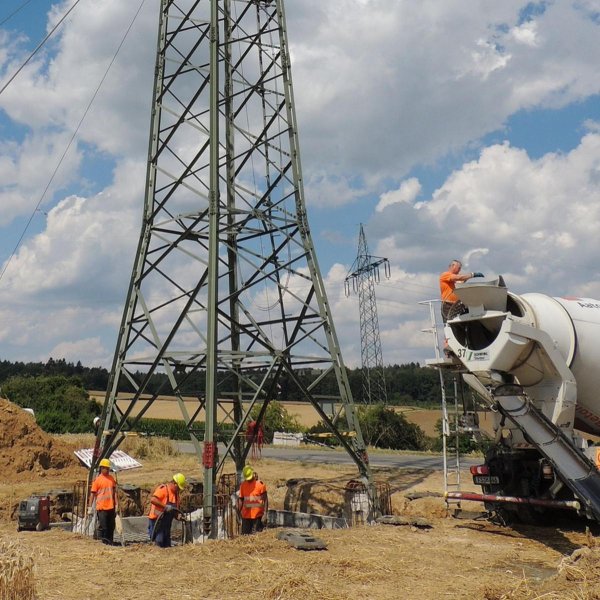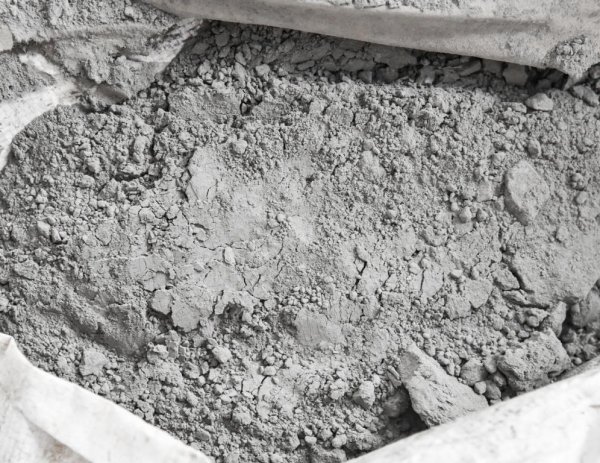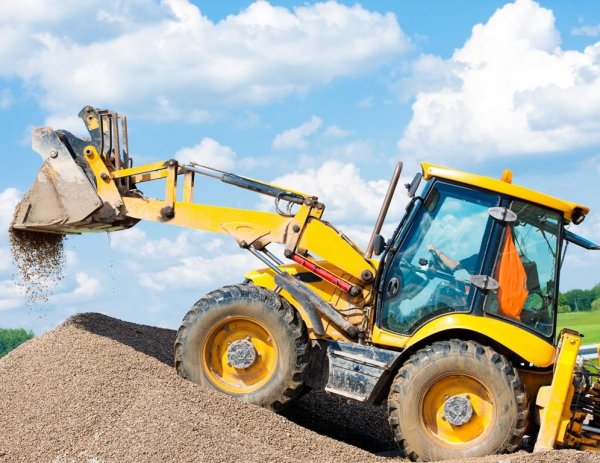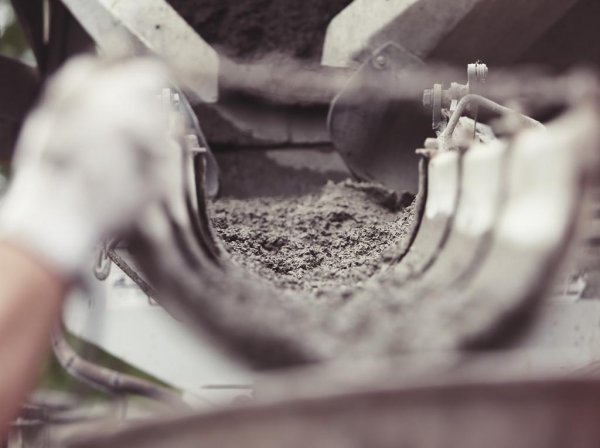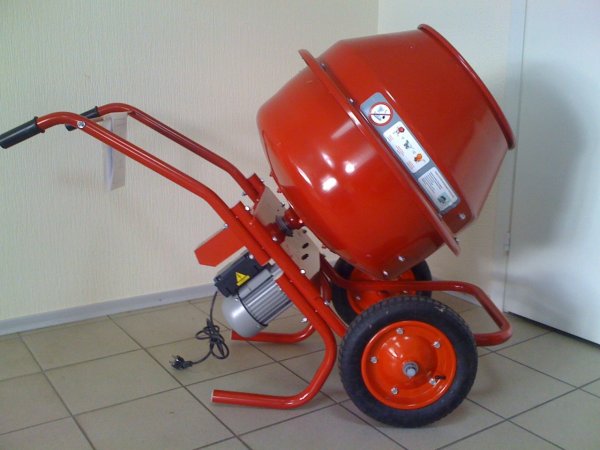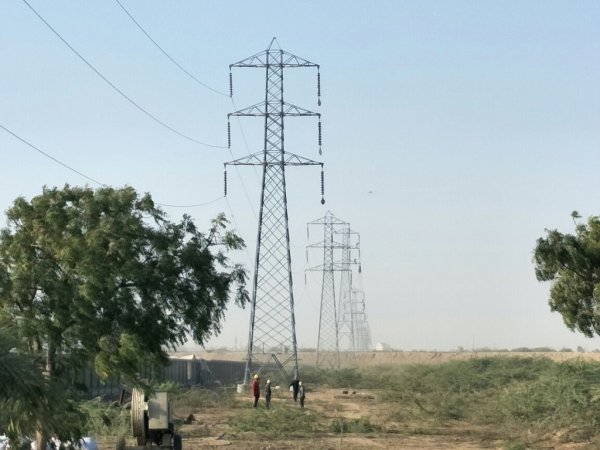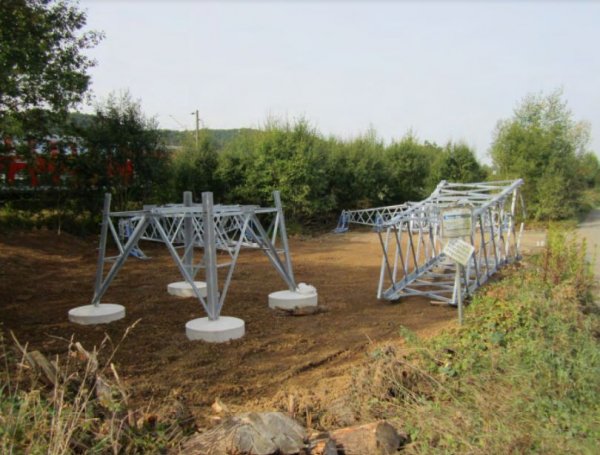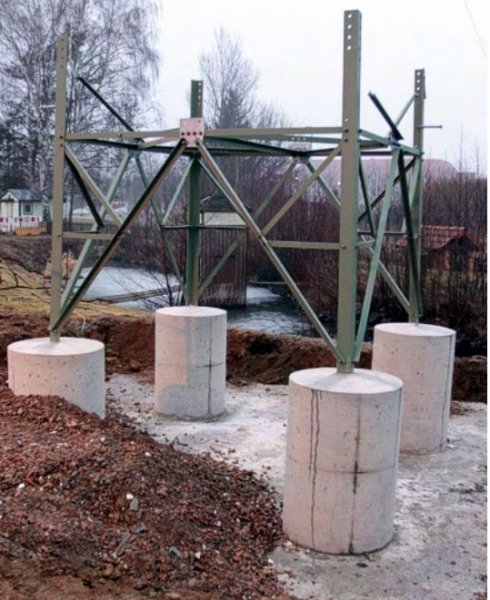Concrete works, concreting of supports for overhead power lines
On overhead power lines, concrete foundations are constructed for certain types of metal intermediate supports with a narrow base for certain types of anchor supports and for all types of corner and raised supports (see — Types and types of overhead transmission line supports).
As a rule, concrete foundations are stepped concrete masses with built-in anchor bolts, to which the heels of the legs of the supports are attached.
The types of foundations are different for different types of supports: for example, wide-base raised anchor supports, as well as portal-type anchor supports, have four identical foundations, one for each support leg. Narrow base supports share a common base for the entire support. Corner supports have large pull-out leg bases located on the outside of the corner and small bases located at the corner of the track.
The volume of concrete works for one support is usually determined by tens of cubic meters. The bases of the supports are concreted mechanically or sometimes manually. Below are the basic data for specific works of overhead power lines.
Concrete and its properties
Concretes are artificial stone materials resulting from the hardening of a mixture of cement and aggregates (gravel, crushed stone and sand) mixed in water. Depending on the method of preparation and the fillers adopted, concretes differ in bulk weight.
Depending on the processing of the concrete and its consistency, concretes differ:
- hard;
- semi-solid;
- plastic;
- voices.
The strength of concrete is understood as the temporary resistance to compression based on the normal working conditions of concrete in building structures.
The strength of concrete with materials of a certain quality and dosage and the same methods of preparation and installation depends on the water-cement ratio (water: cement — W: C). As B: C increases, the strength of concrete decreases.
The temporary compressive strength of concrete is taken as the temporary compressive strength of a concrete cube with an edge side of 200 mm.
Concrete of grades «70» and «90» is usually used for foundations of supports. In the critical foundations of elevated and other special supports, concrete of class «110» and «140» is used.
The content of cement in concrete depends mainly on the brand of cement and the adopted B: C ratio (by weight). For grade 110 - 90 concrete, the amount of grade 300 portland cement can be roughly taken as 200 - 250 km/cm3 depending on the method of placement and the consistency of the concrete. With the use of vibrations, cement consumption is reduced by 15-20%.
The mobility of concrete — its consistency — can be determined in a number of ways. In linear conditions, the most common method is the cone.
The cone is made of sheet steel in the form of a truncated cone with a height of 30 cm with an upper diameter of 10 cm and a lower diameter of 20 cm.The cone is open on both sides and equipped with two handles on top, and in the lower part with two lamellae, with which the cone is pressed with the feet to the place of impact.
The consistency of concrete using a cone is determined as follows. The cone is moistened from the inside and filled with the prepared concrete mixture in 3 layers. Each layer is sewn with a steel rod 25 times. When the cone is full, the excess concrete is cut off with a ruler and the top is smoothed.
The cone is then carefully removed from the concrete table and placed next to it. The concrete released from the form settles a little, more or less, depending on its consistency. Thrust is changed in centimeters by a ruler placed on the adjacent cone.
In order to slow down the adhesion of concrete in the conditions of inevitable transportation of ready-mixed concrete over long distances or, conversely, to accelerate the hardening of concrete during concreting in winter, the following are used: retarders in the form of sulfuric acid in an amount of 0.25 — 0.50% by weight of cement or accelerators in the form of calcium chloride or hydrochloric acid added in an amount of 2% by weight of cement.
The use of accelerators causes a delay in the subsequent increase in concrete strength after the first 3-day intensive period of its hardening. The use of accelerators for the foundations of power lines is not permitted.
Materials for concrete works
The main materials for making concrete are cement, gravel (or crushed stone), sand and water.
a) Cement
Depending on the composition and properties, cements are distinguished: Portland cement, pozzolanic Portland cement, slag port-suem cement, lime-slag cement, lime-pozzolanic cement, aluminum cement and Roman cement.Portland cement is commonly used for power line tower foundations.
Each batch of cement produced by the plant must have a passport that indicates the grade of the cement and the results of the test of the cement produced in the laboratory of the plant, namely:
- setting the time;
- uniformity of volume change;
- fineness of grinding;
- tensile and compressive strength of the samples.
In order to avoid unnecessary losses of cement, which is most often transported in bulk, its delivery to the work area should be carried out in special containers and in any case with a minimum number of overloads.
It is not allowed to unload cement in one bucket from different wagons and even more so from different batches. Each bucket has an index indicating: type, brand, time and other technical data of the cement.
Due to the small amount of concrete work on each picket, the arrangement of warehouses along the route of the power line impractical and it is recommended to store the cement in special boxes with a roof lined with tar paper with a capacity of up to 2 T... Boxes are installed near the pits on special pads to prevent the penetration of moisture.
b) Inert materials (aggregates)
Sand
For concreting; river and mountain sand with a grain diameter of 1.5 — 2.5 mm, with an admixture of clay no more than 2 — 3% by weight, is used for the foundations of the supports. The determination of the content of clay and dust impurities is carried out by elution.
The sand is poured into a cylindrical glass vessel with graduations up to 1/3 of the height and then filled with water almost to the top. After the container is closed at the top with a palm, it is shaken and allowed to settle to clear water.By measuring the height of sand and impurities, the percentage of their content is determined.
Contamination of sand with organic impurities is determined by a color test. A 3% solution of sodium hydroxide is poured into glass containers with sand in a ratio of 1: 1 to sand. The solution is shaken and allowed to settle.
Depending on the degree of contamination of the sand with organic impurities, the water is colored from straw yellow to brownish red.
Sand giving a straw-yellow color is only suitable for concreting non-critical structures with concrete strength «50» or «70». Sand that gives a brown-red color is generally unsuitable for concrete work.
Gravel and crushed stone
Clean gravel or crushed stone with grains or pieces from 5 to 80 mm is used as coarse aggregate for concrete. Contaminated gravel or crushed stone can be applied only after sifting out small impurities and subsequent washing.
Gravel or crushed stone is selected with a strength equal to at least 125% of the strength of a given brand of concrete. Brick crushed stone, in addition to the appropriate strength, should have uniform firing (red color), dense and homogeneous structure. Gravel and crushed stone should be tested for frost resistance. Contamination with organic impurities is checked in the same way as for sand.
Water
The water used for concrete work must not contain harmful impurities. Clean river, lake, well and tap water are usually used. Swamp, polluted factory, as well as stagnant lake water without special research are not used for concrete.
The acidity of water is determined using the litmus test.If the blue litmus test lowered to the inlet turns pink, this indicates that the water contains acid and cannot be used without testing.
To determine the presence of sulfuric acid compounds in water, which are the most dangerous for concrete, the test water is poured into a test tube and acidified with hydrochloric acid (10% of the sample taken). Then add a small amount of 10% barium chloride solution. If the water contains salts of sulfuric acid, a white precipitate forms.
When concreting foundations on standing water or in doubtful cases the quality of the water can be checked by parallel testing of cubes made with test water and water known to be suitable for concrete.
Safety in the development of mining aggregates
In the mechanized extraction of aggregates with the help of excavators, gravity sorting, mechanical screens and sieves, all safety rules provided for working with these mechanisms are observed.
When digging by hand, the excavated soil must be carefully monitored, never allowing deep digging to avoid accidents in case of soil collapse.
The delivery, modernization (enrichment) and delivery of inert materials to pickets is assigned to the construction and installation sections, which perform all the work on the construction of this line.
Formwork
The concrete for the foundations of the power line towers is placed in wooden forms made of panels called formwork, which reproduce the outline of the foundation design exactly with their outline. For formwork, it is allowed to use boards that are not planed, but sufficiently clean and smooth on the inside for easier lagging of the concrete.
In order to reduce the cost of formwork, the latter should be manufactured on special bases and delivered on pickets with ready-made boards. Class II and III timber is used for the production of formwork.
For greater impermeability of the cement solution, the formwork panels are made "in a quarter" and strong enough to be used in several stations. Since during transportation, assembly and disassembly, the shields wear out and require repair, then when calculating the required timber, losses and a margin of 10% are taken into account.
In the pits, the formwork panels are assembled in boxes filled with concrete.
Before installing the lower boxes, to check the compliance of the actual depth of the foundation base with the design one, the final alignment is carried out to the level of the base of all pits.
The greatest accuracy must be observed during the installation of the lower formwork boxes, which largely determine the position of the following boxes and the symmetry of the bases themselves.
The installation of the lower boxes is carried out exactly on the plumb line in accordance with the template installed from above and checked along the axis of the route with anchor bolts suspended from it. After alignment, the longitudinal and transverse walls of the lower box must stand vertically and respectively parallel and perpendicular to the axis of the track and so that the center of the lower boxes coincides with the center of the base of the step.
In this position, the boxes are fixed with spacers in the walls of the pit, after which the formwork is considered installed.The installation and alignment of the next levels of the formwork is carried out with the filling of the lower boxes, and in this case the alignment consists mainly in maintaining the parallelism of the walls of the subsequent boxes to the walls of the previous boxes and in matching their centers with the centers of the lower boxes.
In the case of small protrusions of the lower parts of the foundations against the middle ones, it is allowed to assemble and install the entire formwork at once for all steps of the foundation.
Mechanized dosing of concrete
The concrete mixer is mounted so that it is possible to unload concrete directly onto the tray in the pit. Continuous floor coverings are laid on the sides of the bucket. For convenience when loading a concrete mixer bucket with aggregates, a persistent trolley strap is sewn to the deck near the bucket.
To speed up their delivery to the concrete mixer, the gravel and sand should be placed on the sides of the bucket at a distance of no more than 15 m from the concrete mixer.
A cement box is installed next to the concrete mixer. On the other side of the mixer is a barrel of water.
Before putting into operation, the attachment of the concrete mixer and its motor to the ground should be checked, all friction surfaces should be lubricated, bolts should be tightened and the operation of the entire unit should be checked in motion.
In order to reduce the splashing of cement and ensure a better distribution of cement in the concrete mass during mixing, it is necessary that the cement, when loading the bucket, falls in the middle between the fillers, therefore, sand and gravel are first loaded into the bucket, then the cement metering box is unloaded and then the second batch of aggregates is unloaded. …
After filling the drum, the concrete is mixed by rotating for some time and then unloaded.
Precautions when working with a concrete mixer
- A specially trained person is appointed to work on the concrete mixer, who starts and stops the concrete mixer.
- Unauthorized persons are not allowed to the place of installation of the concrete mixer.
- It is forbidden to stand near the guide channels of the loading bucket of the concrete mixer and under the raised bucket without taking precautions, namely: the mechanism stops and the bucket is firmly fixed; the raised bucket should not be held by the brake but by the ratchet clamp.
- Do not touch the mixing drum or other moving parts of the concrete mixer with your hands while the concrete mixer is operating. If it is necessary to clean the drum of material residues, stop the mixer and make sure that the machine cannot be started accidentally.
- It is forbidden to assist the unloading of concrete from the drum with any device.
- It is inadmissible to carry out repair or lubrication work while the concrete mixer is in motion.
- When stopping, cleaning and lubricating the mechanisms, it is necessary to turn off the engines, remove the drive belt.
- During the repair of the concrete mixer, the cargo bucket is lowered.
- In the event of damage or other malfunctions of the concrete mixer, you must immediately stop work and notify your supervisor.
- Storage of fuel or oil containers near the concrete mixer is prohibited.
Organization of concrete placement work
Before placing concrete in the pit, the following operations are performed: installation, installation, alignment and fastening of the metal template, similar to the one described above for the installation of metal steps.
Hanging anchor bolt templates for laying in concrete base. Anchor bolts must be straight with the correct thread and nuts, free of dirt and protrude from the template by 100 - 150 mm.
Pipe sections should be placed at the top of the anchor bolts to ensure that the bolts "whistle" during the installation of the supports. The height of the pipes is taken as 60 — 70 cm, the diameter is 75 mm. The bolts are wedged with wooden wedges along the axis of the pipe. The installed formwork is checked. The bottom of the pits is freed from foreign objects.
The concrete must be laid before the start of hardening, that is, within a period of no more than an hour and a half from the moment of preparation.
Hand-made concrete is poured into carts, transported to the pit, and dumped into the pit by overturning the carts. It is forbidden to dump concrete into the pit with shovels, as this leads to delamination of the concrete mass.
When making concrete in a picket concrete mixer, the concrete is dumped on a tray directly into the pit. The concrete must be laid in layers no more than 25 cm thick.
Significant savings in the consumption of gravel or crushed stone can be achieved by adding large stones, so-called raisins, to the concrete massifs under construction.
Raisins are placed on a freshly laid unconsolidated layer of mass in a checkerboard shape at a mutual distance exceeding the largest particle size of the stone. Raisins must be clean and meet all gravel requirements. The amount of raisins for stacking should not exceed 20% of the volume of concrete.
Concreting of individual blocks must be done without interruption.
During breaks in concreting, the first joint is allowed only above the footing of the foundation cushion.
In the case of forced breakage, raisins are placed in the top layer of concrete to give the joint a rough surface.
When resuming work, it is necessary to thoroughly clean the surface of the old concrete from dirt and debris, remove the cement film formed at the end of hardening, and rinse the surface with a strong stream of water.
With the composition of the groundwater, which does not pose an immediate danger of destroying the concrete, but does not exclude the possibility of some damage to it, it is necessary to pay special attention to obtaining a dense structure of concrete. In this case, laying concrete with the help of compaction is recommended.
Concrete compaction in those places where there is a source of electricity on the pickets is done with vibrators, otherwise compaction is done manually with rammers.
Concrete vibration should be done immediately after the concrete is placed before it begins to harden. Therefore, before the start of concreting, it is necessary to connect the electrical wiring, examine and test the vibrators, and equip the workers with rubber boots and rubber gloves.
When concreting the base, a surface vibrator and a vibrating head are used.
To reduce the shock transferred to the hands of the workers, the handles are mounted on coil springs.
To avoid delamination of the concrete, the vibrator should be moved to a new location immediately after compaction of the concrete. Vibration and compaction are carried out from the middle of the table to the corners.
At the end of the job, the vibrator is thoroughly cleaned by a concrete worker and checked and lubricated by an electrician.
To allow for periodic inspection and repair of vibrators, one spare vibrator should be kept on picket.
Safety when installing formwork and placing concrete
- When working on the installation of formwork and placing concrete, the following measures must be observed to ensure the safety of the work.
- The axes must be properly mounted on the axes and carefully wedged to prevent the ax from bouncing during operation. Handles and handles must be made of hard wood, planed and smoothed. For the density of the nozzle, it is necessary that the handle protrudes 1 cm from the butt of the ax and is wedged with metal wedges.
- The hammer strike should be slightly convex, not beveled or knocked down.
- It is forbidden to drive an ax into a post, rack, etc. and leave it suspended, as the ax may fall and injure the workers.
- To avoid injuring the legs with an ax when trimming planks or boards, the carpenter should place his right foot further away from the trimmed board.
- When cutting wood with a handsaw, use a piece of wood to guide the cutting blade, not your fingers, and place the object to be cut on a solid support, not on your knee.
- Do not use saws with cracks or broken teeth.
- It is prohibited to carry out work simultaneously above and below (one above the other) in the absence of continuous flooring between workers.
- Do not leave tools on ladders as they may fall and injure people working below.
- Roller boards for delivering concrete in trolleys should not be placed near the edges of the pits.
- When pouring concrete or lowering stones into the trench, it is necessary to warn the excavation workers each time.
- The main formwork must be firmly fixed. It is forbidden to have boards with hammered nails, protruding points upwards, in the workplace.
- When erecting concrete foundations for supports above ground level, scaffolding and ladders are arranged from durable material.
- The floor of the scaffolding and stairs should be cleaned daily of debris, mud, snow and ice, and in wet and frosty weather, sand or ash should be sprinkled several times a day.
- When working with an electric vibrator, its body is reliably grounded, and the cable supplying current to the vibrator must have a protective shield.
- Concrete mixers working with vibrators should wear rubber boots and rubber gloves.
Features of concrete work in winter
Increased requirements are imposed on the storage of aggregates in winter. It is unacceptable for sand, gravel and crushed stone to be mixed with mud and ice, therefore they must be stored on special floors and covered with tar paper.
Special attention should be paid to the washing of aggregates in winter.
Gravel is washed in greenhouses. The gravel is preheated to a temperature of + 10 ° C and then washed with water.
The concrete mixture during preparation and the concrete for the first time after placing can suffer from freezing.
Freezing of concrete can be allowed no earlier than the seventh day after the end of the massif or when a strength of 50 kg / cm2 is reached.
Freshly placed and compacted concrete must have a temperature of at least 1 ° and be in a pit with a positive air temperature. As soon as the air temperature drops, at least temporarily, to 0 °, concreting work must be carried out according to the instructions for winter work, observing the following. It is enough to thaw sand and gravel (crushed stone) so that their temperature is not lower than + 1 °. The water should be heated to 60 — 80 °.
The preparation of the concrete mixture must be carried out in specially arranged greenhouses or in a tent heated by an oven that simultaneously heats the materials. The temperature of the tent floor should not be lower than + 1 ° C.
Experience shows that during the autumn-winter period the temperature in a closed pit remains positive (above 0 °) due to the inflow of heat from the surrounding soil, even if the outside temperature is significantly below 0 °. Therefore, the foundation pit should be excavated in winter immediately before concreting and immediately covered with a layer of wood and a 10 cm layer of loose snow or a 10 cm layer of sawdust, straw mats and similar thermal protection.
A hatch with a cover should be left in the cover for lowering the concrete mixture, which is loaded with trolleys.
In cases where the temperature in the pit has fallen below 0 °, it is necessary to warm it up for several days before placing the concrete and start concreting only when the temperature in the pit rises at least + 1 °.
If in very severe frosts or in a very frozen pit it is not possible to raise the temperature in it due to the heat of the surrounding soil, it is necessary to resort to artificial methods of warming the pit or massif.
Increasing the amount of cement in the batch in winter compared to the amount specified in the table of concrete compositions is prohibited. It is recommended to reduce the addition of water to the batch in winter. Since winter concrete must be thicker than summer concrete, then when laying it, it is necessary to ensure that it is reinforced and well compacted.
Hardening
For the normal setting of positions and compacted concrete, it is necessary to ensure appropriate temperature and humidity. It is recommended to protect fresh concrete from heat and dry winds.
The moisture content of the surface of freshly laid concrete in the summer is achieved by covering it with wet, systematically watered several times a day mats, foam or straw mats.
Such operations are carried out in the first days after placing concrete.
Firing of the formwork is permissible no earlier than the concrete reaches 25% of its design strength. The templates are removed and disassembled only at the end of the concrete work on the four foundations of the support.
Processing of concrete
After removing the formwork, all defects found in the concrete — shells, layers of poorly mixed aggregates, etc. must be carefully removed. To do this, weak concrete is broken off, washed with water and the damaged area is filled with fresh concrete with fine gravel.
In order to protect the concrete masses under the earth's surface from atmospheric influences, the concrete surface is rubbed with cement mortar ("ironing").
Control and acceptance of concrete works
During the period of specific works, a specific work log must be kept at each picket.
At the end of concreting the foundation, its passport is compiled, which is attached, among other documents, to the set of production and technical documentation for this line.
The strength of concrete foundations is determined using control cubes of 20 x 20 x 20 cm, which are made of concrete during its laying in the foundation, on each picket separately.
The cubes are stored in accordance with the mode corresponding to the mode of placed concrete and are marked with the number of the picket on which they were made and the date of their production.
The acceptance of concrete works is carried out on the basis of the results of the test of the control cubes and the test of the concrete in the finished foundation, the inspection of the external dimensions of the foundation, as well as the leveling marks on the upper surfaces of the individual foundations.
The concrete is tested by tapping the walls of the foundation with a hammer. High-quality concrete should emit a clear and sonorous sound.

